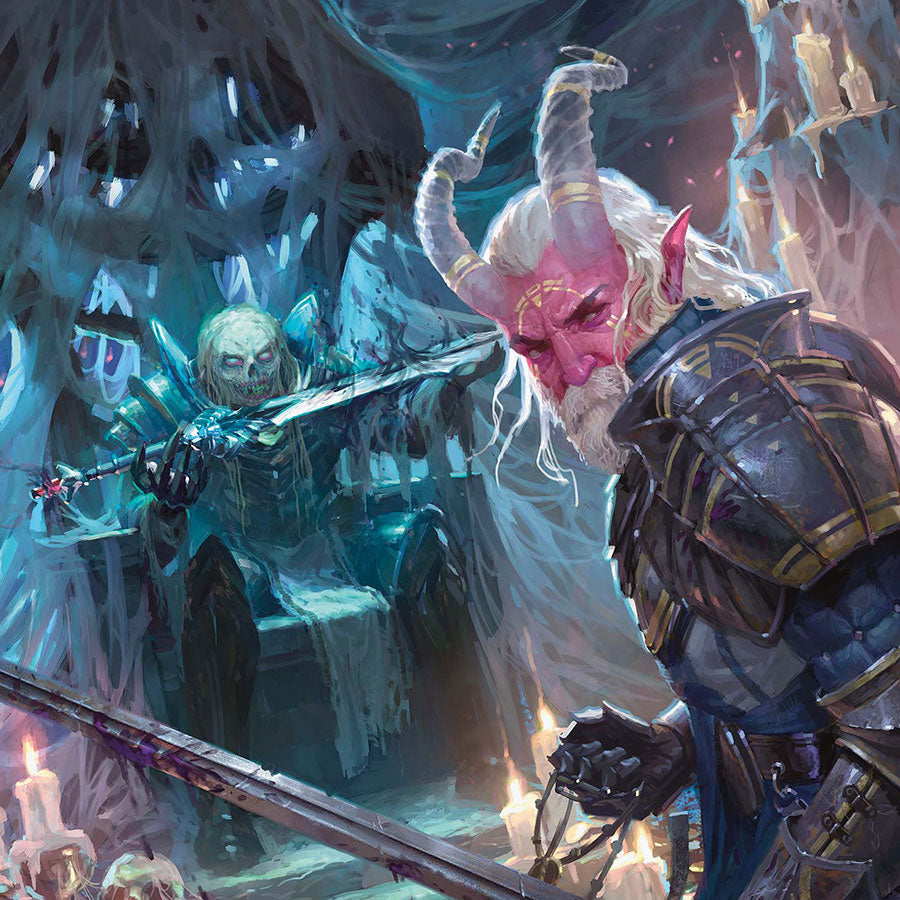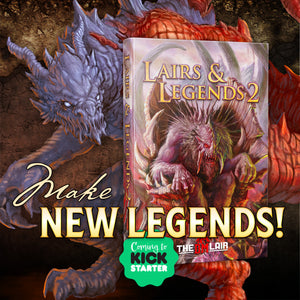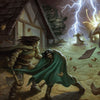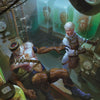D&D Mystery Adventure Mistakes You’re Probably Making

Written by Luke Hart
Hello folks, welcome to the DM Lair! I’m Luke Hart, and on this site, I share my nearly 30 years of game master experience so that you can run amazing games that your players will love. And today we’re talking about running mystery adventures. Specifically, we’ll be discussing several mistakes to avoid and what you should do instead.
Running a mystery adventure can be one of the most rewarding experiences in tabletop RPGs, but it comes with unique challenges that can leave players frustrated if handled poorly. From ensuring players understand they’re solving a mystery to avoiding rigid, linear solutions, the key is to provide engaging clues, meaningful choices, and a sense of urgency without forcing players down a predetermined path. By balancing structured investigation with flexibility, pacing the adventure properly, and keeping clues clear yet compelling, you can craft a mystery that keeps your players hooked until the final reveal.
Now, for the purpose of this post, I’ll be using the term “The Case” to talk about the adventure, “The Crime” to talk about what the players are investigating, and “The Villain” to talk about the solution. However, be aware that not every mystery revolves around a “crime” or a “villain.” It could, for example, revolve around the characters trying to figure out where a long-dead duke hid his will so that his heir can be found to bring political stability back to the duchy.
By the way, if you’re a busy GM without enough to time to prep like you know you should, Lairs & Legends can help. Grab an adventure, read it in about 15 minutes, and you’re ready to run your game! There’s no reason to feel stressed out and overwhelmed before your next D&D game.
Watch or listen to this article by clicking the video below.
1. Not Setting Expectations
Players need to know they’re participating in a mystery. This might seem obvious, but sometimes a lack of clarity can cause players to miss the point entirely. If the characters are exploring an eerie mansion, for example, and you drop subtle hints about an unsolved murder, they might assume they’re on a treasure hunt or about to fight ghosts and not even try to solve the murder! To avoid this, clearly communicate to your players—both in and out of character—that solving the mystery is the goal. Otherwise, your players will be chasing the wrong objective and probably feel pretty lost.
2. Having the Wrong Crowd
Look, not every group is cut out for a mystery adventure. Some players love solving puzzles and piecing together clues, while others find it frustrating or boring. If your group leans more toward kick-down-the-door combat or sandbox exploration, a slow-burning mystery might fall flat. So, pay attention to your players' preferences. If only half the table enjoys mysteries, I would blend investigative elements with other styles of play—such as combats—to keep everyone engaged.
3. The Big Pitfall
It’s tempting to design mysteries that require massive logical leaps inspired by Sherlock Holmes or Hercule Poirot. But here’s the problem: Holmes is written to make those leaps because, well, it’s a pre-written story where the author is in complete control. Your players aren’t. At least I hope they’re not. So, avoid relying on massive leaps of logic to solve the case. Instead, ensure clues connect clearly to the solution. For instance, instead of expecting players to deduce that a half-burned letter means the villain fled to the port, include a more direct clue, like a ship manifest signed by the villain.
4. Not Knowing the Plot
I’m sorry if this seems like a Captain Obvious moment, but as the GM, you need to know the full story behind the mystery. Who committed the crime? Why? Where, when, and how did it happen? Without this foundation, you’ll struggle to guide your players, especially if they go off-script. For example, if your players investigate an unexpected suspect, you should be able to improvise new clues that redirect them toward the real culprit. This is only possible if you’ve fully thought through the plot yourself.
5. Not Knowing the Player Characters
The fact is, mysteries work best when every player feels like they’re contributing to the solution. We’ve all been in the game where one player takes over the show while we all watch, and that is rarely fun. So, to achieve this, understand the abilities and skills of the party. If one player has proficiency in Investigation and another is skilled in Persuasion, create opportunities for both to shine. Don’t hinge the mystery’s solution on a single character’s abilities or, furthermore, leave gaps where no one in the party has the required skill. For example, instead of making the solution depend on a successful Arcana check when no one has that skill, create multiple pathways to uncovering the truth.
6. Not Setting the Tone and Pace
Let’s talk “tone.” Mysteries are all about maintaining an air of suspense and gradual revelation. The characters should uncover information bit by bit until they have enough clues to solve The Crime. Mysteries are a slow burn by design. Even if there are moments of action—like the villain’s minions ambushing the party to throw them off the trail—any clues left behind after such events should never immediately solve The Case. Instead, they should point toward the next significant location or batch of clues.
Maintaining this balance is critical: keep the mystery intriguing but not so drawn out that it becomes frustrating or boring for the players. If the pace slows too much and your players seem disengaged, that’s your cue as the GM to introduce a twist, reveal new information, or otherwise speed things along to re-ignite their interest.
7. Not Using the Rule of Three
Every significant location in your mystery should have at least three clues available for the players to discover. Additionally, there should be at least three clues that point toward each significant location. Your mystery should also include at least three significant locations to explore and three suspects for the characters to investigate.
If you have fewer than three of any of these elements, your mystery will likely feel thin, leaving players without enough leads to follow. For example, if the players are investigating a murder at a noble’s estate, there might be a bloodstained letter (a clue leading to a blackmailer), muddy footprints (leading to a stablehand), and a shattered vase (hinting at a struggle). Multiple clues and locations ensure the characters always have options and the story keeps moving forward.
8. Forcing a Location
While some adventures may be tied to a specific place, such as an old mansion on a hill, all mysteries are inherently Event-Based adventures. This means they require flexibility on the part of the GM and an open playing field for the players to explore. Even mysteries that take place entirely in one location, known as Closed Circle mysteries, follow the structure of an event-based adventure, where events and clues drive the story rather than the confines of the setting itself.
9. Not Using a Timer
To add urgency and keep things dynamic, consider introducing a timer. For instance, “At dawn, the mansion will be sold at auction, the characters will lose access to the location, and The Villain will escape.” Alternatively, you might use a timer to heighten tension after the players uncover the truth: “You now know who The Villain is and why they committed The Crime, but if you don’t reach the final location and confront them within the hour, they will kill again!” These time constraints add stakes and prevent the mystery from feeling static.
10. Forcing a Linear Solution
Mysteries, more than any other type of adventure, must avoid being railroaded or having a linear solution. The Case should unfold organically, giving the players freedom to decide where and how to investigate The Crime. Resist the urge to create a rigid 1-2-3 structure where one clue leads directly to the next location, and so on. From the very beginning, your players should have multiple leads or options to follow, with each clue they uncover pointing to several potential next steps.
Also, be very careful not to let any of the initial leads take them straight to the final solution of The Case. For example, if the first location points directly to The Villain’s hideout, the mystery will feel shallow and anticlimactic. Instead, design the leads to branch out in various directions, creating a web of interconnected clues and locations.
11. Not Splitting the Party
Look, if you’re going to run a mystery adventure, you should probably embrace the tropes of mystery fiction by giving players the opportunity to split up if they choose. If they do, adjust your encounters accordingly to account for smaller groups. For instance, if the party divides to explore different leads and combat breaks out, scale the threats so they remain challenging but not overwhelming. Since you’ve already set the expectation that they’re in a mystery, don’t penalize them for following these classic storytelling patterns. Now, to be clear, I don’t usually recommend scaling encounters if the group splits up, but a mystery adventure isn’t our standard fare.
12. Using Red Herrings
In fiction, mysteries often include red herrings to mislead the audience and keep them guessing. However, in a TTRPG, red herrings should be used cautiously—or avoided altogether. You see, players have a tendency to overanalyze clues and confuse themselves without the GM’s help. Introducing deliberate dead ends can lead to frustration and cause the players to spiral as they try to fit irrelevant information into the bigger picture.
If you do choose to use a red herring, always include a clue at the end that makes it clear they’ve reached a dead end and directs them back to a meaningful lead. For example, the players might interrogate a suspicious merchant who turns out to have no involvement in The Crime but reveals new information about the real suspect’s whereabouts.
If your players are fans of “Holmes-like” police procedurals such as Castle, Elsbeth, or The Mentalist, you can use a classic trope to signal the dead end. Have the police or city guard latch onto the red herring as their main theory of the case. In these types of shows, the initial police solution is almost always wrong, signaling to the protagonists—and the players—that they need to look elsewhere for the real answer.
13. Not Preparing for Failure
As the GM, you already know the solution to The Case, but your players don’t. It’s inevitable that they’ll miss clues, interpret information incorrectly, or simply take the investigation in an unexpected direction. While it’s okay for the characters to fail, that failure should never stem from your lack of preparation.
Be ready to redirect the players back to The Case when things go off course. One way to do this is by introducing a new clue. For example, if they overlook something critical at a crime scene, you might have a helpful NPC mention a suspicious figure or an overlooked piece of evidence. Alternatively, have The Villain commit another crime, creating fresh leads that point back to the main mystery.
If The Villain is aware of the PCs’ investigation, they might try to stop them through misdirection or even outright attacks. For instance, an ambush by the villain’s agents could fail but leave behind a map or item that reorients the players toward the right path.
The one thing you must avoid is outright handing the players the solution. The satisfaction of a mystery comes from the players feeling like they earned their victory. Even if you need to nudge them along, let them believe they solved The Case through their own cleverness and determination.
14. Screwing Up Clues
Clues are the bread and butter of any good mystery. Each location the players investigate should have at least three clues available, ensuring they have multiple chances to gather important information. However, no single clue should provide the entire solution to The Case. Instead, each clue should offer a small, relevant piece of information—a hint about The Villain’s identity, motive, or methods—or direct the players to another significant location to continue their investigation.
For example, the players searching a suspect’s home might find a hidden letter implying blackmail (hinting at motive), a pair of muddy boots (suggesting involvement at a particular site), and a torn piece of fabric matching the crime scene. These clues don’t solve the mystery on their own but add layers to the puzzle.
The best clues often implicate multiple suspects or leave room for interpretation. It’s only through collecting and cross-referencing multiple pieces of information that the players can determine which suspect is truly The Villain. For instance, a fingerprint might point to several people with access to the crime scene, but when paired with evidence of a forged will and a financial motive, the picture becomes clear. Thoughtful clue design ensures the players feel challenged but never entirely stuck.
15. Not Varying Clue Methods
The methods for discovering clues should be diverse, using each character’s skills and catering to different play styles. Avoid relying solely on Perception/Seek checks. For example, clues might involve Lore to decipher a symbol, Survival to track footprints, or other unique skills.
Include social interaction clues, like questioning NPCs or reading their body language. These can require skill rolls, like Persuasion to get a reluctant witness to talk, but don’t penalize players who struggle to phrase questions themselves—let their characters’ skills shine.
Most importantly, essential clues—the ones the players need to solve The Case—should always be givens if they visit the right location or NPC. Don’t hide these behind skill rolls that might fail. For example, an obvious letter on the desk ensures the mystery progresses smoothly.
16. Not Placing Clues Correctly
Clues need to guide the players toward other significant locations in The Case. Furthermore, each location should contain at least three clues pointing to other places that keep the investigation moving.
However, avoid placing clues to the final location too early. Ensure clues leading to the solution are only found in locations reached later in the investigation. This prevents the players from stumbling onto the answer too soon and creating an anticlimactic ending. For example, the villain’s hideout might only be revealed after piecing together multiple clues found in mid- or late-game locations.
17. Not Filling in Gaps
Clues don’t always have to lead directly to solving The Case. The GM can use clues to fill in gaps in the story or provide background information and lore that might not otherwise come out during the adventure.
For example, a torn family portrait found in the villain’s lair might reveal their motive or hint at connections to a broader conflict. Just ensure these clues enrich the story and make the adventure feel more complete, without misleading players or turning into a red herring.
18. Not Sticking the Landing
The Case should lead to a satisfying payoff: the final showdown with The Villain. This could be an intense battle or a dramatic confession where the villain admits defeat once they know "the jig is up." For example, cop shows often end in action, while more Holmesian mysteries like Castle or Sherlock focus on intellectual victories.
Tailor the conclusion to your players’ preferences. If they enjoy combat, give them an epic fight. If they prefer the satisfaction of solving the mystery, a surrender works just as well. Remember, you can add tension by including a ticking clock, such as needing to confront the villain “before they kill again.” This keeps the ending exciting while ensuring it feels earned and climactic.
Get Loads of 5e Adventures and Resources for Your Games!
As a new dungeon master, I was overwhelmed with everything I needed to do. Learn the rules, create the adventures, run the game, handle problem players—it was A LOT! And even as a veteran DM, it’s still a lot. You might even feel that way yourself.
If you’re looking for loads of 5e adventures that you can prep in under 30 minutes or elements such as traps, puzzles, and encounters that you can drag and drop into your game at a moment’s notice, we have you covered!
With Lairs & Legends and Loot & Lore, you’ll get over 700 pages of 5e resources:
- Twenty-nine 5e adventures spanning levels 1 to 15 and designed for groups of 4 to 6 players.
- Over 100 new creatures from CR 0 to CR 24.
- Adventure Ideas
- Encounters with Full-Color and Blackline Digital Maps
- Patrons & Factions
- Magic Items
- NPCs
- Puzzles
- Random Encounter Tables
- Random Tables
- Spells
- Subclasses
- Traps
- Villains
Everything is designed to be EASY TO USE and QUICK TO PREP for your game. Our goal is to make game masters’ lives easier, not more complex!
Don’t spend another moment frustrated and overwhelmed as a GM. Pick up the Lairs & Legends Ultimate Bundle today and find out how much easier being a GM can be!
-
Posted in
Game Master How-To Articles







